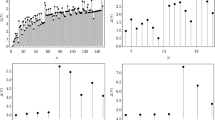Summary
The Morse inequalities linking the critical points of a potential function on the whole configuration space and its restrictions to either planar or linear configurations are derived from the Morse theory in its equivariant form. Brute potential functions arising from standard models of quantum chemistry need eventually morsification which can be achieved without altering the main chemical significances of the potential. Illustrative applications follow in the case of magnesium clusters.
Similar content being viewed by others
References
Born M, Oppenheimer JR (1927) Ann Phys 84:457
Morse M (1934) Calculus of variation in the large. Am Math Soc Colloquium Pub 18
Spanier EG (1966) Algebraic topology, McGraw Hill, NY
Greenberg M (1966) Lectures on algebraic topology. Benjamin, NY
Palais RS (1970) Critical point theory and the minimax principle. Global Analysis. Proc. Sym Pure Math 15:198 A.M.S. Providence
Mezey PG (1988) Chem Phys Lett 82:100; 86:562 (1982)
Liotard D (1979) Thesis, Pau
Liotard D (1983) In: (eds. Maruani, Serre) Symmetries and properties of non-rigid molecules, p. 323, Elsevier, NY; Iratcabal P, Liotard D (1988) J Am Chem Soc 110:4919
Peterson MR, Gsizmadia IG, Sharpe RW (1983) J Mol Struct (Theochem) 94:127
Mezey PG (1987) Potential energy hypersurfaces, Elsevier, NY
Mezey PG (1980) Theor Chim Acta 54:95
Fadell E, Neuwirth L (1962) Math Scand 10:111
Pacella F (1987) Arch. rat. Mech. Anal. 97:59
Palmore JI (1976) Lett Math phys 1:119 and ref. therein
Cardy H, Dargelos A, Liotard D, Poquet E (1983) Chem Phys 77:287
Liotard D, Roche M (1987) J Comp Chem 8:850
Pacella F (1986) Trans Am Math Soc 297:41
Gilmore R (1981) Catastrophe theory for scientists and engineers, Wiley, NY
Durand G (1989) J Chem Phys 91:6225
AMPAC, version 2.1, Dewar research group, University of Texas at Austin, 78715 Austin (TX)
Liotard D, Penot JP (1981) In: (ed. Della-Dora), Numerical methods in the study of critical phenomena, p 213, Springer, Berlin Heidelberg New York; Liotard D (1992) Int J Quant Chem 44:723
Bockisch F, Liotard D, Rayez JC, Duguay B (1992) Int J Quant Chem 44:619
Davidson E. R (1977) J Am Chem Soc 99:397
Mezey P. G (1977) In: (ed. Czismadia), Applications of M.O. theory in organic chemistry, p 127, Elsevier
Author information
Authors and Affiliations
Rights and permissions
About this article
Cite this article
Liotard, D., Rérat, M. Equivariant Morse theory of theN-body problem: Application to potential surfaces in chemistry. Theoret. Chim. Acta 86, 297–313 (1993). https://doi.org/10.1007/BF01128519
Received:
Accepted:
Issue Date:
DOI: https://doi.org/10.1007/BF01128519




